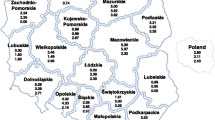Abstract
Objective
To report the percentage of non-vaccine pneumococcal serotypes and their antibiotic susceptibility pattern in children with invasive peumococcal disease.
Methods
Invasive pneumococcal isolates of children <5 years during January 2007 to December 2016 were serotyped by a co-agglutination reaction and sequential multiplex polymerase chain reaction.
Results
Among the total 170 S. pneumoniae invasive isolates, 54 (31.8%) and 44 (25.9 %) were the serotypes, which are not included in current 10-valent or 13-valent vaccines, respectively. Very low resistance was observed against penicillin (4.5%) and all isolates were susceptible to cefotaxime.
Conclusions
One-fourth to one-third of the S. pneumoniae serotypes in under-five children with invasive pneumococcal disease are not covered by existing pneumococcal vaccines in India.
Similar content being viewed by others
References
Johnson HL, Deloria-Knoll M, Levine OS, Stoszek SK, Hance LF, Reithinger R, et al. Systematic evaluation of serotypes causing invasive pneumococcal disease among children under five: the pneumococcal global serotype project. PLoS Med. 2010;7:e1000348.
Tocheva AS, Jefferies JM, Rubery H, Bennett J, Afimeke G, Garland J, et al. Declining serotype coverage of new pneumococcal conjugate vaccines relating to the carriage of Streptococcus pneumoniae in young children. Vaccine. 2011;29:4400–4.
dos Santos SR, Passadore LF, Takagi EH, Fujii CM, Yoshioka CR, Gilio AE, et al. Serotype distribution of Streptococcus pneumoniae isolated from patients with invasive pneumococcal disease in Brazil before and after ten-pneumococcal conjugate vaccine implementation. Vaccine. 2013;31:6150–4.
Tocheva AS, Jefferies JM, Christodoulides M, Faust SN, Clarke SC. Distribution of carried pneumococcal clones in UK children following the introduction of the 7-valent pneumococcal conjugate vaccine: a 3-year cross-sectional population based analysis. Vaccine. 2013;31:3187–90.
Greve T, Møller JK. Accuracy of using the lytA gene to distinguish Streptococcus pneumoniae from related species. J Med Microbiol. 2012;61:478–82.
Lalitha MK, Thomas K, Kumar RS, Steinhoff MC, the IBIS Study Group. Serotyping of Streptococcus pneumoniae by coagglutination with 12 pooled antisera. J Clin Microbiol. 1999;37:263–5.
Veeraraghavan B, Jayaraman R, John J, Varghese R, Neeravi A, Verghese VP, et al. Customized sequential multiplex PCR for accurate and early determination of invasive pneumococcal serotypes found in India. J MicrobMethods. 2016;130:133–5.
Balsells E, Guillot L, Nair H, Kyaw MH. Serotype distribution of Streptococcus pneumoniae causing invasive disease in children in the post-PCV era: A systematic review and meta-analysis. PLoS One. 2017;12:e0177113.
Jaiswal N, Singh M, Das RR, Jindal I, Agarwal A, Thumburu KK, et al. Distribution of serotypes, vaccine coverage, and antimicrobial susceptibility pattern of Streptococcus pneumoniae in children living in SAARC countries: A systematic review. PLoS One. 2014;9:e108617.
Brueggemann AB, Pai R, Crook DW, Beall B. Pan India distribution of pneumococcal serotypes (PIDOPS) causing invasive pneumococcal disease and pneumonia in children between 6 weeks and 5 years and their antimicrobial resistance–Phase I. PediatrInfectDis. 2016;8:47–51.
Manoharan A, Manchanda V, Balasubramanian S, Lalwani S, Modak M, Bai S, et al. Invasive pneumococcal disease in children aged younger than 5 years in India: A surveillance study. Lancet Infect Dis. 2017;17:305–12.
Nisarga R, Premalatha R, Shivananda Ravikumar KL, Shivappa U, Gopi A, et al. Hospital-based surveillance of invasive pneumococcal disease and pneumonia in South Bangalore, India. Indian Pediatr. 2015;52:205–11.
DM, Malley R, Lipsitch M. Serotype replacement in disease after pneumococcal vaccination. Lancet. 2011;378:1962–73.
Ozawa D, Yano H, Endo S, Hidaka H, Kakuta R, Okitsu N. Impact of the seven-valent pneumococcal conjugate vaccine on acute otitis media in Japanese children: Emergence of serotype 15a multidrug-resistant streptococcus pneumoniae in middle ear fluid isolates. Pediatr Infect Dis J. 2015;34:e217–21.
Waight PA, Andrews NJ, Ladhani SN, Sheppard CL, Slack MP, Miller E. Effect of the 13-valent pneumococcal conjugate vaccine on invasive pneumococcal disease in England and Wales 4 years after its introduction: an observational cohort study. Lancet Infect Dis. 2015;15:535–43.
Author information
Authors and Affiliations
Corresponding author
Rights and permissions
About this article
Cite this article
John, J., Varghese, R., Lionell, J. et al. Non-vaccine Pneumococcal Serotypes Among Children with Invasive Pneumococcal Disease. Indian Pediatr 55, 874–876 (2018). https://doi.org/10.1007/s13312-018-1398-x
Received:
Revised:
Accepted:
Published:
Issue Date:
DOI: https://doi.org/10.1007/s13312-018-1398-x




